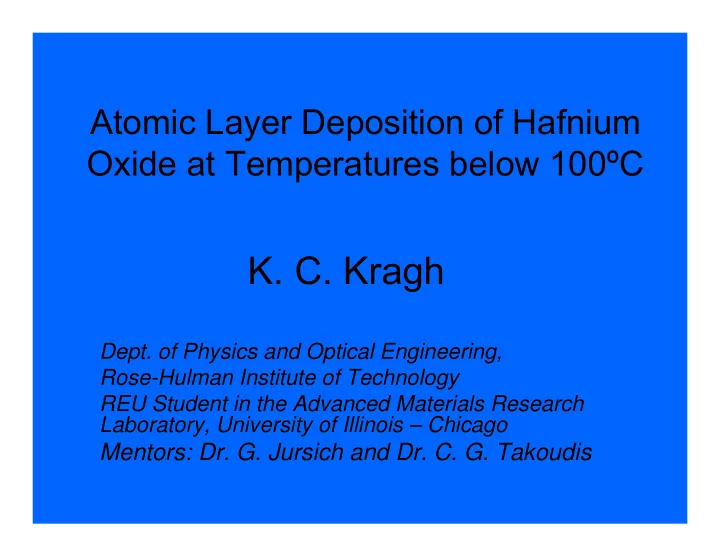

Atomic Layer Deposition of Hafnium Oxide at Temperatures below 100ºC K. C. Kragh Dept. of Physics and Optical Engineering, Rose-Hulman Institute of Technology REU Student in the Advanced Materials Research Laboratory, University of Illinois – Chicago Mentors: Dr. G. Jursich and Dr. C. G. Takoudis
Objectives • To examine low temperature Atomic Layer Deposition (ALD) growth of HfO 2 on Si • To verify the composition of low temperature HfO 2 films • To deposit HfO 2 on polymer fibers for creating nanotubes
Thin film layers compose the structures of micro-scale technology. • International Nomenclature – MEMS: Micro Electro Mechanical Systems – MST: Micro Systems Technology • Applications to every scientific field Al Ti SiO 2
Nanoscale thickness of layers requires a separate deposition technique Atomic Layer Deposition (ALD) Precursor Oxidizer Hf(N(C 2 H 5 ) 2 ) 4 H 2 O One Atomic Layer
Process Overview • Control Parameters • Substrate Preparation & Insertion • Lower the Reactor Pressure • Reaction • Raise the Reactor Pressure • Removal of Substrate • Analysis
ALD Reactor
Analysis of Film Thickness • Spectral Ellipsometer – Material Model – Calibrated Reflection – Sample Preserved • Low Temperature Results – Nonuniformity – Variation in values
Average Thickness after 50 cycles for a 5s Pulse Time with various Reactor Temperatures 250 200 Average Thickness (Å) 150 100 50 0 20 40 60 80 100 120 140 160 Reactor Temperature (ºC)
X-ray Photoelectron Spectroscopy (XPS) identifies elements by binding energy. Source: 1486.6 eV Al K α The photon (hf) must overcome – Work Function ( φ ) – Binding Energy (B.E.) Resulting Data from: B.E. = hf – K.E. – φ Sample Destroyed By Photoemissive Electrons Image: Simon Garrett http://www.cem.msu.edu/~cem924sg/Topic09.pdf
Examine the Complete Survey XPS Survey across HfO 2 deposited on Silicon at 60ºC 531 eV O 1s 213 eV and 224 eV Hf 4d 5/2 and 4d 3/2 17eV Hf 4f 381 eV Hf 4p 3/2 439 eV Hf 4p 1/2 282 eV C 1 s 1000 800 600 400 200 0 Binding Energy (eV)
Examine the Hf 4f Doublet 062308 Reactor at 60ºC for 5s pulses XPS Hf 4f scan after sputtering Intensity (a.u.) 19.3 eV 17.6 eV 22 20 18 16 14 Binding Energy (eV)
Confirm HfO 2 Films at Low Temperatures • Peaks are in place 30ºC 40ºC 60ºC 70ºC 80ºC • 15.8 eV Bulge is Hf-N Bonding Intensity (a.u.) 22 20 18 16 14 Binding Energy (eV)
Inorganic nanotubes are the focus of increasing research. • PCL Fibers (Poly- Caprolactone) • Hafnia tubes by ALD • Applications: – Electrical – Chemical – Mechanical PCL Fibers from Dr. A. Yarin Top Image: Berserker79 http://en.wikipedia.org/wiki/Image:Pcl_synthesis.png Right Image: Dr. Alan W. Nicholls & K. C. Kragh
Cautions & Considerations for Polymer Fibers • Temperature Operation • Careful Loading • Rigid Support • Slowly Dropping Pressure • Heating Strip Caution
Problems & Concerns • Melting Temperature ~ 60ºC – Aldrich Polycaprolactone (PCL) Beads – Worrisome deposition – Drop to sub-60ºC runs • Time Per Run • Quality of Fibers
Pressure Variations • Worried about Blowing out Fibers • Tried Lengthen the Distance – Tube Temperature Concerns – Deposition Rate Concerns • Tried Grating Possibilities • Solution: Steel Envelope
Examination of HfO 2 Coated Fibers Scanning Electron Microscope (SEM) – Scattered Electrons – High Magnification – Composition found by Energy Dispersive X-ray (EDX) – Back-Scattering for relative Atomic Number
Uncoated and Coated PCL Packets
Hafnium Oxide on PCL Fibers by Back-Scattering
EDX Composition of HfO 2 PCL Fibers
Conclusions and Future Work • ALD growth of HfO 2 films will occur down to room temperature of 30ºC on Si & PCL • ALD could be used to create hafnia nanotubes with polymer heating Future Work: Heat out the PCL to create the actual nanotubes and evaluate their properties
Photo References • Garrett, Simon J. 2001. Special Topic in Analytical Chemistry (CEM 924) Resource Page. http://www.cem.msu.edu/~cem924sg/index.html. Accessed 2008 June 16. • Berserker79 http://en.wikipedia.org/wiki/Image:Pcl_synthesis.png • All SEM photos captured on the Hitachi S-3000 N Scanning Electron Microscope operated by Dr. Alan W. Nicholls, Director of Research Service Facility and Electron Microcopy for University of Illinois at Chicago • All other figures and graphs from K. C. Kragh
Acknowledgements • National Science Foundation (NSF) • Department of Defense (DoD) • Grants: NSF-EEC 0755115 & NSF-CMS 0829903 • Professor G. Jursich • Professor C. G. Takoudis • Professor A. Yarin • Dr. Alan W. Nicholls • Adam Kueltzo • Qian Tao • Manish Singh • Suman Sinha Ray • Lin Jiang
Recommend
More recommend